




大学入試をはじめ、アメリカで何かと書く機会が多いエッセイ(Essay)。
日本で言うところの小論文やレポートに該当するエッセイ(Essay)を書くためには、ライティング力だけでなく基本的な決まり事やテクニックを知っておく必要があります。
アメリカでは、小学生の頃から少しずつエッセイについて学びはじめ、中学校ではより本格的に書き方について指導を受けるようになります。
今回は、実際に娘が学校で書いたエッセイを引用しながら、7年生までに学ぶエッセイライティングの基礎についてまとめていきたいと思います。小論文やレポートを書く際にぜひ参考にしてみてください。
この記事の著者:MIZUKI
アメリカで中学生と小学生、2人の娘を育てているMIZUKIです。我が家は日本人家族で、夫も私も英語はあまり得意ではないですが、子どもたちはバイリンガルへと成長中!アメリカでの子育てや学校を通じて知った、さまざまな英語教育についての情報をお伝えできればと思っています。
中学校のエッセイのライティングレベルは?
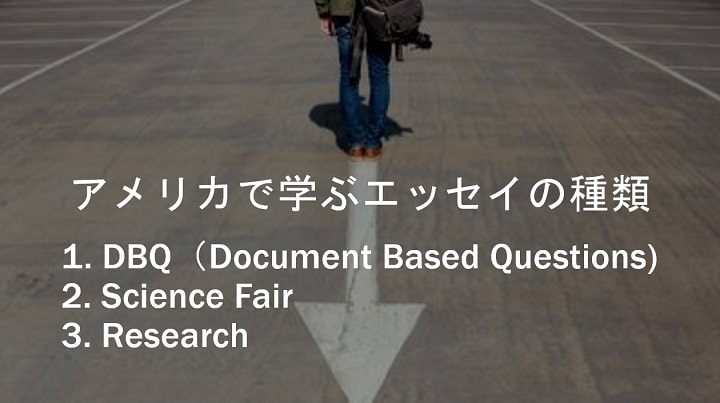
今回ご紹介するのが中学校で学ぶエッセイライティングの基礎と聞いて、高校や大学で書くような英文エッセイの役に立つのか?と疑問に感じる方もいらっしゃるかもしれません。
しかしアメリカでは、中学生でも十分にレベルの高いエッセイを書いているというのが私の印象です。
また、内容はともかくとして、日本の高校生〜大人の英語学習者でも、エッセイを書くためのテクニックは知識として持っておくと役に立ってくれるはずです。
例えば、娘の通う中学校では、英語の授業以外でも下に紹介するようなエッセイを書いています。
社会学や科学などの授業で書くものは、より論理的にまとめる必要があり、エッセイの型やフォーマットなども厳しくチェックされます。
DBQ(Document Based Questions)
DBQとは、社会学の授業の一環で、娘たちの通う学校では5年生(小学校の最終学年)から年に2回行うことが義務付けられている課題です。
さまざまな考え方ができるような問題が出され、それについて与えられた資料をもとに、自分の意見をエッセイで述べていきます。
例えば、娘が7年生のときの社会学では「アフリカをヨーロッパが統治下においていたとき、ヨーロッパがどのような手段でそれを可能としていたのか」ということについてessayをまとめるという課題がありました。
娘は「資材の豊富さ」「テクノロジーの進化」「医学の発展」といった内容を資料から抜粋してまとめたとのことですが、どれが正解ということはなく、自分の意見にいかに説得力を持たせられるかということが重要となってきます。
ほかに、アメリカの開拓について、第二次世界大戦についてなどを過去のDBQのエッセイではまとめています。
Science Fair
年に1回行われるScience Fairでは、自分でテーマを見つけ、仮説をたてて実験を行い、その結果と考察をまとめます。
このレポートの中で仮説をたてたり考察をまとめたりする時に、アカデミックなエッセイの形式が使われます。
娘たちの学校では、Science Fairに4年生から参加しますが、大学などで発表するときに使われるものとほぼ同じフォーマットに則ってまとめることになっているため、理系に進みたい生徒にとってはとてもいい経験になっていると感じます。
Research
科学系の授業であるResearchでは、与えられた課題をもとにインターネットなどで調べてエッセイを書きます。
7年生では「病原体に対する免疫の反応と免疫細胞の種類」について学んでいたため、課題として与えられた病気について「病原体や症状、治療法」について書いたそうです。
このように、アメリカでは中学生でもアカデミックなライティングの経験を十分に積んでいける環境にあるのです。
英語のエッセイの書き方とフォーマット
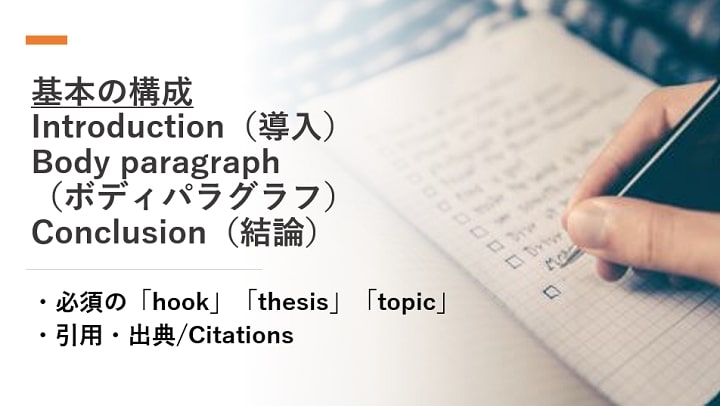
それでは最初に英文エッセイの基本の型となるフォーマットといくつかのコツを、実際のエッセイから例文を引用しながら説明していきます。
こちらの例文は英語の授業で娘が書いたもので、タイトルは「Technology Obstruction in Classrooms(テクノロジーによるクラスの妨害について)」です。
必要なところは、その都度抜粋して説明していきますが、分かりやすい内容ですので全体にも目を通していただければと思います。
また、エッセイにはさまざまなタイプがありますが、今回引用するエッセイは「Argumentative essay(自分の主張を述べるエッセイ)」になります。
段落(Paragraph)の基本構成
英語のエッセイは、基本的に「Introduction(導入)」、3~7つの「Body paragraph(ボディパラグラフ)」、「Conclusion(結論)」という段落から成り立っています。
また、他の媒体からの引用した内容を含む場合には、最後に「Citation(引用・出典)」を載せます。
エッセイで文字数が決められている場合は、この中からボディパラグラフの数を増減させて対応していきます。
また、導入と結論はできるだけ簡潔にまとめることを意識してください。
必須の「hook」「thesis」「topic」
英文エッセイでは、以下に挙げる3つのセンテンスが重要とされ、必ず取り入れることが求められます。
- 「hook sentence(フックセンテンス)」:興味を引くためのセンテンス。導入で使われる。
- 「thesis sentence/statement(エッセイの主題文)」:エッセイ全体をとおして自分が述べたいテーマとなる「主張」について書かれたセンテンス。導入と結論で使われる。
- 「topic sentence(段落ごとの主題文)」:各段落ごとの「topic(論点)」について書かれたセンテンス。ボディパラグラフで使われる。
詳しくは、このあと各段落の説明の中で述べていきます。
論点(Topic)を決めておく
エッセイを書き始める前に、自分の意見の骨組みを作る「topic(論点)」のアウトラインを考えましょう。
論点とは、簡単に言えば自分が主張したいテーマに対し、なぜそう思うのかを考えるための「きっかけ」や「問い」のことを言います。
この論点がはっきりしているとライティングが書き進めやすくなるのは、日本語でも英語でも変わりありません。
また、この論点の数が、そのままボディパラグラフの数になるのが一般的です。
導入/Introduction
エッセイの導入部分になります。イントロダクションでは、書かれている内容に興味を持たせること、自分の主張を先に述べておくこと、続くボディパラグラフで取り上げる論点について簡単に触れておくことが求められます。
太字でアンダーラインを引いた例文が、上に挙げた重要な部分にあたります。
Technology. An extremely powerful tool, yet a device that questions the user’s responsibility and maturity at the same time. As technology evolves, more and more of it becomes integrated into the classrooms. While it can act as a useful resource that provides access to the internet, its potential can also cause disruption in the classes. Technology in the classroom can get in the way of learning because of access to games, distraction, and inability to monitor. In the near future that awaits, this is not a problem that can be ignored for both the instructors and the pupils. In order to build a better learning environment in the classrooms, there needs to be a way to properly deal with the devices and technological mechanisms so that it will be benefiting the whole.
エッセイの書き出しは、読者に興味を持ってもらえるように始めます。
Technology. An extremely powerful tool, yet a device that questions the user’s responsibility and maturity at the same time.
この書き出しの冒頭に書かれたセンテンスが、興味を引くための「hook sentence(フックセンテンス)」です。エッセイを書く上で重要なパートとなります。
また、今回のエッセイの冒頭では「Technology.」と単語だけが書かれていますが、これは「sentence fragment(文の断片)」と呼ばれ、普通は使わない単語だけという形をあえて使うことで文章にインパクトをプラスし、読者の興味を引くというフックセンテンスで使われるテクニックの一つです。
次に、自分の意見を述べる箇所があります。
While it can act as a useful resource that provides access to the internet, its potential can also cause disruption in the classes. Technology in the classroom can get in the way of learning because of access to games, distraction, and inability to monitor.
このパートでは、エッセイ全体をとおして主張したいテーマを簡潔にまとめてあります。これが「thesis sentence/statement(エッセイの主題文)」です。
そしてセンテンス内に出てくる「access to games」「distraction」「inability to monitor」の3つが今回のエッセイの論点となっています。
このように、導入で論点を明記することにより、このあとのボディパラグラフで、どのようなことについて論じていくのかを、クリアにしておきます。
また、「thesis sentence/statement(エッセイの主題文)」では、一人称を使うことを避けるというのも大切です。
一人称を使わないことで、客観的な視点をもって述べられた意見として、より冷静で強い印象を与えることができるためです。
ボディパラグラフ/Body Paragraph
自分の主張について、論点をもとに理由や証拠を述べるパートになります。3~7つの段落で構成されますが、中学校で書くエッセイは基本的に3つのボディパラグラフで構成されるそうです。
各段落の最初のセンテンスが「topic sentence(段落ごとの主題文)」にあたり、その段落内で述べる論点について書かれます。太字でアンダーラインを引いているので確認してみてください。
また、導入で明記した論点の順に合わせて、ボディパラグラフも進めていきましょう。
Body #1
「access to games(ゲームへのアクセス)」について論じています。
The first reason is that they grant children unlimited access to games.(Body#1の主題文) This is something that can be observed in classrooms on an everyday basis, where children get on their iPads and play games during the instructions, or during the work session. For instance, a student can access the internet when they are supposed to be working, and be playing games the whole class. Since the iPad is usually unmonitored, other than the exception of during a test or a note-taking session, the students are able to go onto the internet and play some games without being noticed. Even if an adult or a teacher comes by, they can merely press the home button, and pretend to be doing their work. Furthermore, there are no limitations forbidding the iPads to go on the game sites, which allows unlimited access to be possible. According to Joel Levin (2014), a New York City teacher who presented how the game Minecraft could be used in schools, described the effects of introducing the game as “his students’ consuming interest in the game overriding other areas of study”. This proves that exposure to games can keep us off track from work. As a generation growing up surrounded by technology, it is hard for us to keep our hands off of the screens already. As the students gain more and more accessibility to games, the more distracted they will be from their studies. With this, their grades will gradually start to drop, and it may end up greatly affecting their school life. Though access to the internet can be a great help and be very useful in assignments, that does not mean that all students will always be on what they are supposed to be. With the evidence above, unlimited access to games on technology is becoming a growing problem in technology based classrooms.
Body #2
「distraction(注意の散漫)」について論じています。
Other than access to games, another reason why technology can get in the way is because of distraction.(Body#2の主題文) This refers to the students becoming distracted with the technology itself, as well as the distraction it may cause for the people around them. For example, during a work session, a student becomes distracted and starts to look up things that are unrelated to the schoolwork. The student sitting next to them may also become distracted due to curiosity of what their classmates are looking at. In this case, both of their grades will be affected, for the distraction of technology is keeping them from doing their work. In another example, a student could be listening to music without their headphones. This causes great disruption for the ones who are sitting around the person. An individual could be distracting themselves and unintentionally distracting their classmates. This can be proven by the statement on the Harvard University website (n.d.), that reads, “mobile device usage is distracting to neighboring students”. This shows that not only does the wrong usage of technology distracts the student, but causes disruption among the surrounding area. Certainly, a student could fully distract themselves with their devices. The generation in school right now is the generation that with technology all around them. Naturally, the knowledge is abundant about devices too. Nowadays, the students can delete the history and other evidence about their off-task activities, eliminating the worries of supervisors standing in their way when they repeat the action again. Without another individual stopping them, they will not know better than to once again perform the self-distracting process and as a result subconsciously affecting their grades negatively.
Body #3
「inability to monitor(監視の難しさ)」について論じています。
Furthermore, the last and the most important reason as to why technology can get in the way of learning is the inability to monitor the student’s activities.(Body#3の主題文) This is the biggest reason as to why technology can obstruct the children from learning. Even when a student is being off-task during class, if the instructor doesn’t know about it, they can not prevent them from being on apps/websites that are unrelated to their schoolwork. In addition, even if a pupil reports their classmate being off-task, if their technology is not being monitored, there is not a single evidence to prove their claim. Though a check of their history might act as a proof, they are now capable of deleting their history before being checked. If no proof is found and the student is not punished, there is a high possibility of them repeating the action, resulting in disruption for their classmates. If this gets really troublesome, looking from the students’ perspective, a student warning the distracted individual could be blamed unfairly for interrupting the class. In most cases, the instructor will most likely ask what happened. Still, even if the pupil that had warned the other told everything honestly, as long as the person being warned does not confess that they were doing it, there is no evidence to prove who is saying the truth and who is not. In those kind of situations, with a device to monitor the students’ technology, there can be evidence to support the reporting classmate. If a monitoring device can not be prepared, the instructor themselves walking around the classroom could make some difference. Julie Davis (2015), a tech coordinator, states in an article, “If a student has no idea if I might walk past them while I teach, they are less likely to be off-task”. Like as this person writes in this phrase, the teacher moving around the classroom will most likely make a difference in the number of people being off-task as well as allow the teacher to get a closer look at their students’ behavior to see who they often witness being on unrelated sites and such. In my opinion, I think it would definitely reduce the stress of the class to have solid witness when consulting a teacher about a disruptive member. Now, some people may claim that monitoring the students’ screens seems like an invasion of privacy. I do not think that this is true. If the students are doing their schoolwork, there shouldn’t be anything private on their screens in the first place. This is why student screens should be monitored.
結論/Conclusion
まとめのパートです。ボディパラグラフの内容を改めてまとめ、結論を述べます。こちらも重要なセンテンスにはアンダーラインが引いてあります。
With the reasons above, I conclude that technology can get in the way of learning in classrooms as more and more of it becomes integrated into the curriculums. The three main reasons for this is because of access to games, distraction, and inability to monitor. While it may be a good resource, and definitely be a great tool for research, it just might have far too much potential for the students to handle. This is not as much of a problem when observing elementary school classes, but once the middle school students are observed, maybe even high school classes, that just might not be the case. The adults may be thinking that the students are behaving, but do the teachers know really what’s going on the screens that they hold? The dozen tabs they have open of games and searches unrelated to their schoolwork? The ridiculous search history and photo albums that they have stocked? Of course, I will not deny the fact that there are certainly responsible individuals who are properly and efficiently using the technology for their studies. On the other hand, I can also not deny the fact that there are indeed people that fit in the descriptions in which I have given above. As a student myself, I would like to ask a question to those students. Is the enjoyment gained through the many distractions worthy to use the study time in class for?
結論の中で、以下のセンテンスが導入でも出てきた「thesis sentence/statement(エッセイの主題文)」です。
With the reasons above, I conclude that technology can get in the way of learning in classrooms as more and more of it becomes integrated into the curriculums. The three main reasons for this is because of access to games, distraction, and inability to monitor.
導入のときと、まったく同じ言い回しにならないように気をつけましょう。
そして、ここまで読んで分かるように、英語のエッセイを書くときには「最初に主張を述べる」「論点をもとに自分の主張の理由などを述べる」「最後にもう一度主張を述べる」というのが全体の流れの基本です。ぜひこの流れをおさえておいてください。
また、今回引用したような「Argumentative essay(自分の主張を述べるエッセイ)」では、結論の中で、自分の意見について読んでいる人に問いかけるという手法がよく取られます。
Is the enjoyment gained through the many distractions worthy to use the study time in class for?
上の、結論の最後の一文が、その問いかけにあたります。
引用・出典/Citations
エッセイを書くにあたって、引用した文献を載せます。
OPINION: Gamifying the classroom is a bad idea. (n.d.). Retrieved March 4, 2019, from http://america.aljazeera.com/opinions/2014/3/videogames-in-theclassroom.html
Technology and Student Distraction. (n.d.). Retrieved March 5, 2019, from https://bokcenter.harvard.edu/technology-and-student-distraction
Davis, J. (2015, February 19). Classroom Management Tips for the Technology Rich Classroom. Retrieved March 5, 2019, from https://www.edutopia.org/discussion/classroom-management-tips-technology-rich-classroom
ここで引用・出典を書くために使われているのは、「APA format」と呼ばれる形式です。こちらはアメリカの大学で一番使われることの多いフォーマットになります。
引用や出典を書くにあたっては多くの決まりごとがありますが、インターネット上にあるサイトを使えば、完璧に覚えなくても大丈夫です。
例えば、娘の学校では以下のサイトが使われています。
http://www.citationmachine.net/#
このサイトで「APA」を選択したあと、「BOOK」「MAGAZINE」「WEBSITE」などから自分が引用した媒体を選びます。
そして、本であればタイトルや著者名、ウェブサイトであればURLを打ち込むと、該当するものが一覧となって出てくるため、そこから自分が使った引用元を選択し「FINAL STEP」に進みます。
最後に、できあがった「Citations」をエッセイにコピー&ペーストして終了です。


段落の基本とコツ
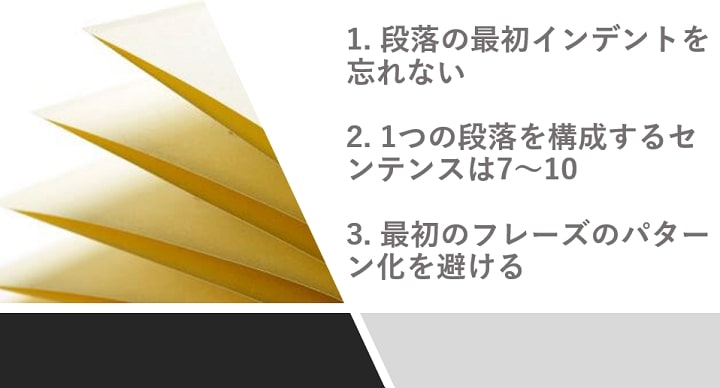
続いて、段落の基本について見ていきましょう。
インデントを忘れない
段落の最初はIndent(インデント:段落の行頭を下げること)を必ず行います。新しい段落で改行するごとにインテンドをすることを忘れないようにしましょう。
インデントのスペースは指導する先生によっても異なるようですが、大体5~10文字分のスペースを空けます。
パソコンでエッセイを書く場合は、「tab」キーを押すと自動的にインデントが入ります。
段落内の理想のセンテンス数
1つの段落を構成するセンテンスは7~10が理想的です。
特に、センテンスの数が少ないというのは、エッセイの採点の際に大きなマイナスポイントとなるため気を付けましょう。
逆にセンテンスが多い場合は、15くらいまでは許容範囲ですが、長すぎると文章をまとめきれていないとみなされ、やはりマイナスな印象を与えます。
上で引用した娘のエッセイでは、5つの段落内でそれぞれセンテンスの数が7、13、14、17、11となっています。
3つ目のボディパラグラフのセンテンス数がオーバーしていますが、内容的に必要なセンテンスであると判断されたため、先生からもOKが出たものと思われます。
最初のフレーズのパターン化を避ける
各段落のスタートの言葉は、ワンパターンにならないようにしましょう。
例えば今回の英文エッセイでは、各ボディパラグラフの冒頭で以下のようなフレーズが使われています。
The first reason is that they grant children unlimited access to games.
Other than access to games, another reason why technology can get in the way is because of distraction.
Furthermore, the last and the most important reason as to why technology can get in the way of learning is the inability to monitor the student’s activities.
便利な表現集・接続詞
他にも、スタートのフレーズにはさまざまなものがあります。便利な表現集を下に載せますので、参考にしてください。


センテンスの基本とコツ

続いて、段落を構成するセンテンスについて見ていきましょう。
基本となる6つの流れ
センテンスを書くときには、その流れを意識することで各段落にまとまりが出ます。基本となる流れは6つあり、その中で必要な部分を膨らませて、7~10のセンテンスを書いていきます。
エッセイのBody#1を例として引用しますので、娘が中学校で実際に教わってきた説明文とともに参考にしてください。
sentence 1: (topic sentence) – make one claim about the overall topic of the essay that relates to the thesis
段落内でどのような論点について述べるのかを書きます。
The first reason is that they grant children unlimited access to games.
sentence 2: explain why the topic sentence is true, or develop it further
論点についてなぜそう思うのかを述べる、もしくは、論点をさらに掘り下げて説明していくパートになります。
This is something that can be observed in classrooms on an everyday basis, where children get on their iPads and play games during the instructions, or during the work session.
sentence 3: give an example of the claim made in the topic sentence (make a “for instance” statement)
自分の主張をサポートしてくれる例をあげます。引用した例文では、3つのセンテンスを使って例をあげて説明しています。
For instance, a student can access the internet when they are supposed to be working, and be playing games the whole class. Since the iPad is usually unmonitored, other than the exception of during a test or a note-taking session, the students are able to go onto the internet and play some games without being noticed. Even if an adult or a teacher comes by, they can merely press the home button, and pretend to be doing their work.
sentence 4: give another example of the claim to better support it
自分の主張に、より説得力を与える他の例をあげます。以下のように、Furthermore(さらに)のような接続詞を入れることで、読んでいる人にも分かりやすくなります。
Furthermore, there are no limitations forbidding the iPads to go on the game sites, which allows unlimited access to be possible.
sentence 5: support the claim with even more specific information (this is where integrating an outside source can be helpful)
引用などを用いることで意見にさらに説得力を加えます。また、その引用がどのように自分の意見を証明してくれるのかについても述べていきます。
According to Joel Levin (2014), a New York City teacher who presented how the game Minecraft could be used in schools, described the effects of introducing the game as “his students’ consuming interest in the game overriding other areas of study”. This proves that exposure to games can keep us off track from work. As a generation growing up surrounded by technology, it is hard for us to keep our hands off of the screens already. As the students gain more and more accessibility to games, the more distracted they will be from their studies. With this, their grades will gradually start to drop, and it may end up greatly affecting their school life. Though access to the internet can be a great help and be very useful in assignments, that does not mean that all students will always be on what they are supposed to be.
sentence 6: write a sentence that wraps up the paragraph (an “in conclusion” sentence)
段落ごとに、書かれている内容を簡単にまとめます。
With the evidence above, unlimited access to games on technology is becoming a growing problem in technology based classrooms.
他のボディパラグラフも、同じような流れに沿っています。ぜひ確認してみてください。


センテンスを書くときのポイント
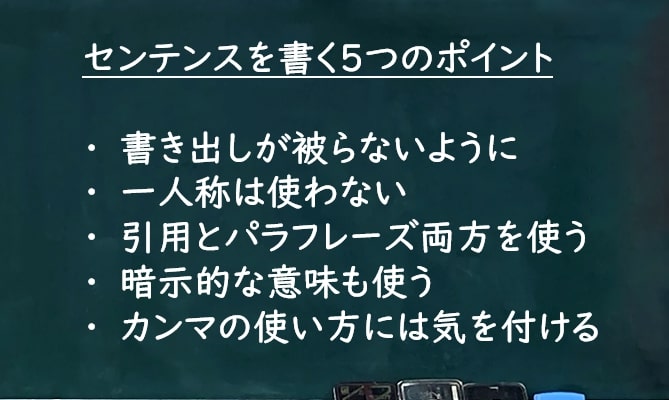
最後に、センテンスを書くときに気を付けていきたいポイントやコツをご紹介していきましょう。これらを意識することで、より洗練されたエッセイを書くことができます。
続くセンテンスの頭がかぶらないように
段落内で続くセンテンスでは、書きだしをかぶらないようにするということが大切です。
特に「A」や「The」は一般的に使われることが多く、かぶってしまいがちです。使いすぎないように工夫しましょう。
エッセイのタイプによって一人称を使わない
今回引用している、「Argumentative essay」は、自分の意見を述べるものなので、「I think」や「I believe」のような言い回しが使われることがあります。
しかし、事実だけを述べる「Factual essay(事実に基づくエッセイ)」や「Informational essay(情報を伝えるエッセイ)」では、一人称を使うことはありません。
あくまでも事実をもとにした客観的な書き方を心がけてください。
直接引用とパラフレーズの両方を使う
「direct-quote(直接引用)」とは、「“」を使って、さまざまな媒体に書かれている文章をそのまま引用することを言います。
一方「paraphrasing(間接引用)」は、情報だけを取り入れて自分の言葉で書くことを言います。
一つのエッセイの中では、この両方を使うことが望ましいとされます。特に引用が続く場合には、直接引用が多用されないように、うまく間接引用を使っていきましょう。
直接引用を使うより、自分の言葉で書くことのできる間接引用を使ったほうが、文章の流れが作りやすいというメリットもあります。

明示的な意味(denotation)だけでなく暗示的な意味(connotation)も意識する
「denotation」は辞書などに書かれている意味、そして「connotation」とは、その言葉が内包している意味のことを言います。
例えば「shack」「house」「mansion」にはすべて「家」という意味がありますが、「shack」には「掘っ立て小屋」、「house」には「庶民的な家」、「mansion」には「豪邸」という意味もあります。この後者の意味が「connotation」です。
エッセイでは、一般的な意味だけでなく、その言葉が持つ印象を大切にすることで、より正しく意図を伝えることができます。ぜひ単語を覚えるときに意識してみましょう。

カンマの使い方
文章の中でいくつかの英単語を並べたときに「A, B, C and D」と書く方は多いと思います。
しかし、「A, B, C, and D」というように、andの前にもコンマを入れるのが論文などでは正式な形とされており、このandの前に入るコンマが「Oxford-comma」と呼ばれます。
最近では大学入試なども含め、この「Oxford-comma」が使えているかどうかをチェックされることが増えているようです。正しい使い方を身につけていってください。
まとめ
エッセイの基礎についてご紹介してきました。あくまでも中学校までに学んでいる内容なので、実際にはもっとさまざまなテクニックが必要となっていきます。
一方、基本としてここまで書いてきた内容を知っておくと、大学入試だけでなく、TOEFLやIELTSのライティングにも取り組みやすくなると思います。
また、エッセイを書くときには、「導入」から書き始めるのが一般的ですが、まず「ボディパラグラフ」から書き始めて、その内容に合わせて「導入」パートをあとから書くという手もあります。
特にテストなどで時間がないときには、「ボディパラグラフ」を書きながら自分の意見をまとめていくことで、「導入」の「thesis sentence/statement(エッセイの主題文)」が書きやすくなります。ぜひ試してみてください。
文法などを中高でしっかり教わる日本人は、英語で文章を書くのが上手だと言われております。
基本となるポイントをおさえてテクニックを身につけることで、英語のライティングが得意になる可能性は十分にあります。ぜひ前向きにエッセイに取り組んでいきましょう!











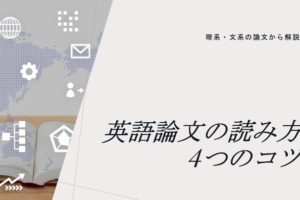



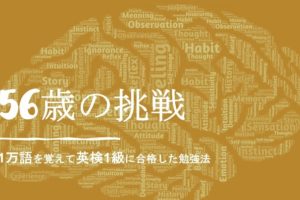

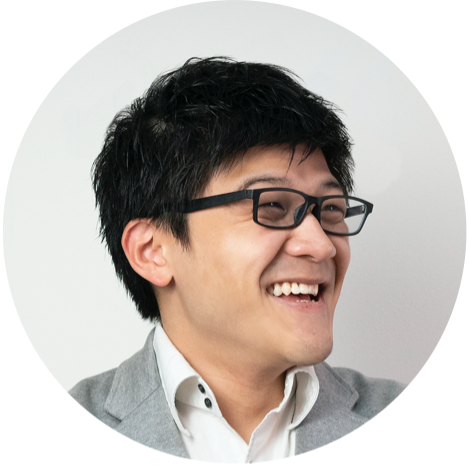




はじめまして。通りすがりの塾講師です。
とある東南アジアの国でインターナショナルスクールや日本人学校に通う子供たちの
ライティングの添削を行っています。
まだまだ未熟で、いつもIntroductionの指導法に悩んでいましたが、
今回素晴らしい例文付きで、とても分かりやすく、勉強になりました。
アメリカではこのレベルのエッセイを中学生で書くということに驚きを感じています。
(日本の子供たちは同様のエッセイを日本語で書ける子は少数ではないかと思います)
他のページも見て参考にさせていただきます。
ありがとうございました。
どういたしまして!たしかに、日本の中学校では日本語でもこのレベルで議論したり自分の考えをまとめる機会は少ないと思う・・
アメリカは子供たちに考えさせたり、クリエイティビティを刺激する教育がすごく発達しているね!日本にも普及させたい!
はじめまして。愛知県内の国際系の学部に通っている大学1年生です。
今年、大学に入学してからエッセイの授業を受けてきましたが、オンライン授業ということもあり、なかなかエッセイの構造や書き方を授業内で理解することができませんでした。そんな中ダメ元で英作文の方法をネットで調べた所、この記事に出会いました。
まだまだ完璧とまではいきませんが、この記事を参考として、今ではだいぶしっかりとしたエッセイが書けるようになりました。
より良いエッセイが書けるようにこれからも頑張りたいと思います。
まるゆうさん
嬉しいコメントありがとう!!この記事がお役にたてて良かった!!
これからもどんどん有用な記事を出していくね!一緒にがんばっていこう!